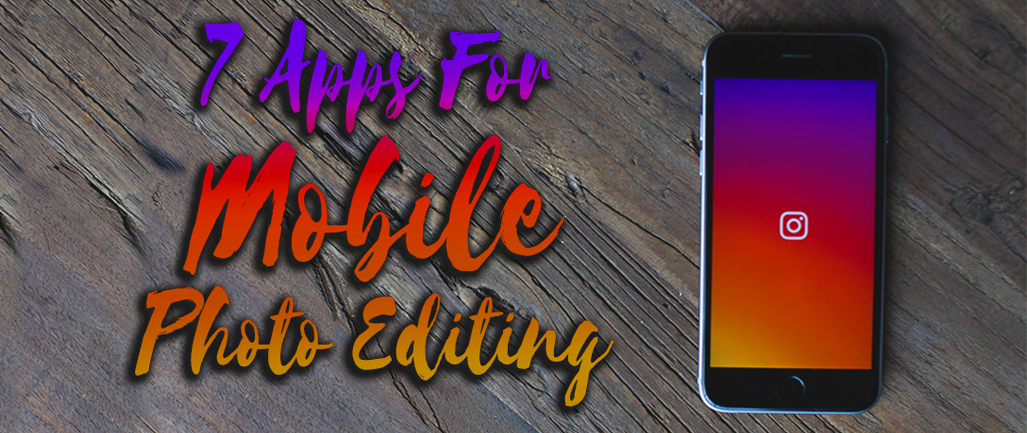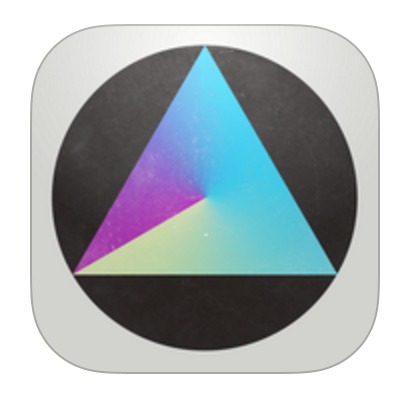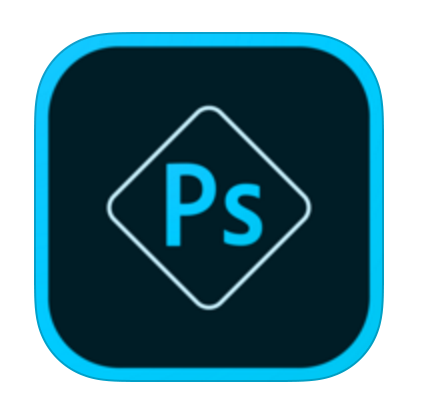
The Instagram app (sometimes fondly known as Insta) was originally designed with simple editing features. You selected a photo, applied one of a few nonadjustable filters, and posted. Done!
Now the app offers many more editing tools, including the option to soften the opacity of a filter for a less-dramatic effect. Despite the increased flexibility, Instagram remains a fairly simple app that doesn’t try to do too much. For this reason, many people use another app (or several others) to edit their photos and videos before uploading to Instagram.
Adobe Photoshop Express
I love Adobe. Their mobile apps are now many in number, and they just keep getting better and better. For those of you with Adobe Creative Cloud, these apps are designed to integrate seamlessly with your account to help you flow from mobile to web to desktop apps easily.
Photoshop Express was the first app I discovered from Adobe, and I immediately fell in love with its tools and setup, which will feel familiar to anyone who spends time in the desktop version of Photoshop.
While the filters leave a lot to be desired, the light- and color-correction tools are great. I especially love correcting both temperature and tint, and it’s the only app I’ve found that effectively reduces noise. That’s critical for a grainy shot taken in low light or for softening a too-sharp photo that shows every wrinkle or pore in the subject’s face. You’ll need to sign up for a free Adobe account to access that last feature, but it’s well worth the effort.
All of the edits are nondestructive, meaning they can be removed or adjusted. For people who are used to Camera Raw or layers in Photoshop (and for anyone, really), this makes for a much better way to work.
Photoshop Express also includes a variety of borders, as well as blemish and red-eye removal features. For lots more retouching features, though, check out Adobe’s companion app, Photoshop Fix.
Adobe Photoshop Fix
Wherever Photoshop Express falls short, Adobe fills the void with Photoshop Fix.
Edits in Fix are also nondestructive, and it includes basic light and color correction, though Express still has a few more options. That’s why I’ll sometimes use the two apps in tandem.
I love the full-Photoshop features Fix incorporates, such as liquify, clone stamp, and spot healing. It’s also impressive because you can apply corrections (such as smoothing, sharpening, defocusing, and light and color adjustments) over certain areas rather than affecting the whole image. You can add an adjustable vignette (choose the color, shape, and feather amount). It is even possible to paint color onto the image, and then blend as needed. Within Fix, you can also see the camera specs (shutter speed, aperture, etc.).
Adobe Lightroom
 The Lightroom app from Adobe is my new favorite. For those who use the desktop version of Lightroom, Adobe Bridge, or Camera Raw, this app gives you both editing and organization all in one place.
The Lightroom app from Adobe is my new favorite. For those who use the desktop version of Lightroom, Adobe Bridge, or Camera Raw, this app gives you both editing and organization all in one place.
Start by creating collections and importing photos. Rate images with zero to five stars, choose one of three different flags, and sort or filter your view based on those and other criteria.
When you edit, you’ll have access to more than just basic sliders. Click the circle in the left bottom corner to access tone curve (a very adjustable vignette), dehazing, and even split toning, as well as color and black-and-white controls.
I LOVE the color controls—use these to adjust the hue, saturation, and luminance (darkness or lightness) of a single color, giving you control over subtle color issues that can’t be fixed with tint or temperature.
Use split toning for gorgeous effects. Try adding a little orange to the highlights and blue to the shadows, or give an outdoor image a sunny glow with a bit of yellow in the highlights and orange in the shadows, then adjust the balance to skew more to the shadows.
Best of all? You can apply the edits you made in a previous photo to the next one with a single tap. This is such an amazing shortcut when you have a group of photos from a similar situation that all need extensive editing.
Whitagram
 When Instagram was first released, it only allowed users to post square images. Now, you can post a portrait- or landscape-oriented image, but there are still limits. Very wide or very tall images will be cropped to some extent.
When Instagram was first released, it only allowed users to post square images. Now, you can post a portrait- or landscape-oriented image, but there are still limits. Very wide or very tall images will be cropped to some extent.
I use the app Whitagram to get around this issue. It simply adds space around the image. This space can be white or a color. You can adjust the image size within this frame. Whitagram also includes image-editing tools and a few fun things like stickers and a meme creator. I don’t use these features much, since the former is rather limited and the latter generally costs extra.
Faded
 Faded is a great app when you want to just play. Search #madewithfaded on Instagram to see some of the awesome creations by its users!
Faded is a great app when you want to just play. Search #madewithfaded on Instagram to see some of the awesome creations by its users!
Add vintage and grunge looks with preset filters, light leaks, dust + scratches, gradients, color overlays, and more.
My favorite aspect of this app is that you’re not limited to one filter or effect. Use as many as you like! I also love that you can tweak the effects (opacity, color, etc., depending on which one).
That being said, there are two cons to Faded. One, it is destructive, meaning that it’s hard to go back more than a step or two if you don’t like the results. Two, the app has an unfortunate tendency to crash every once in a while, which can be really frustrating.
Layout
 Layout was the first companion app introduced by the makers of Instagram. It allows you to combine two or more images into a simple collage. Collages were already popular when Layout arrived on the scene, but some of the other apps out there can be cheesy. Plus, you can move to Layout from directly within Instagram when you start a new post, and import back to Instagram quite easily.
Layout was the first companion app introduced by the makers of Instagram. It allows you to combine two or more images into a simple collage. Collages were already popular when Layout arrived on the scene, but some of the other apps out there can be cheesy. Plus, you can move to Layout from directly within Instagram when you start a new post, and import back to Instagram quite easily.
Once you select your photos, Layout offers different options for that number of images. You can adjust the size of the spaces; zoom, flip, mirror, or move each image; and add a white border between images, if you wish. Layout allows you to save to your camera roll and send to Instagram, Facebook, or another compatible app.
One thing I discovered with Layout is that it’s important to edit the color, exposure, and such before making your collage. Once you’re back in Instagram, it can be difficult to choose a filter that makes every image look good if one shot is dark, another a bit warm, and so on. For this, I generally use Adobe Photoshop Express (see below).
Boomerang
 Gif lovers will love Boomerang, also made by Instagram. It takes a burst of photos and loops them together into a super short video.
Gif lovers will love Boomerang, also made by Instagram. It takes a burst of photos and loops them together into a super short video.
The result can be shared on Instagram, Facebook, or other apps, and the video automatically saves to your camera roll. Keep in mind that while Boomering allows you to capture in portrait or landscape mode, the video will be cropped (at least slightly) when you bring it into Instagram. Next, apply filters, trim the clip, and choose a cover image to share that one simple loop—or add more clips to create a longer video.
Bonus: Hyperlapse
 We’ll call this one a bonus, since Hyperlapse falls slightly outside of “photo editing.” But let’s cover it for the sake of thoroughness.
We’ll call this one a bonus, since Hyperlapse falls slightly outside of “photo editing.” But let’s cover it for the sake of thoroughness.
When I think about creating a long time-lapse video, I think of a professional camera, a heavy-duty tripod, a power source, sandbags, a giant thermos of coffee …
But to make a short time-lapse video, the process doesn’t have to be that involved. Hyperlase simplifies the process by creating smooth time-lapse videos even when your camera isn’t perfectly stable—and even when you’re actively moving. Speed up the footage within the app, then share to Instagram or Facebook, or save to your camera roll.
What apps do you use for mobile photo editing? Tell us in the comments below!
Keep learning about the use of technology in your church by subscribing to this blog!


























